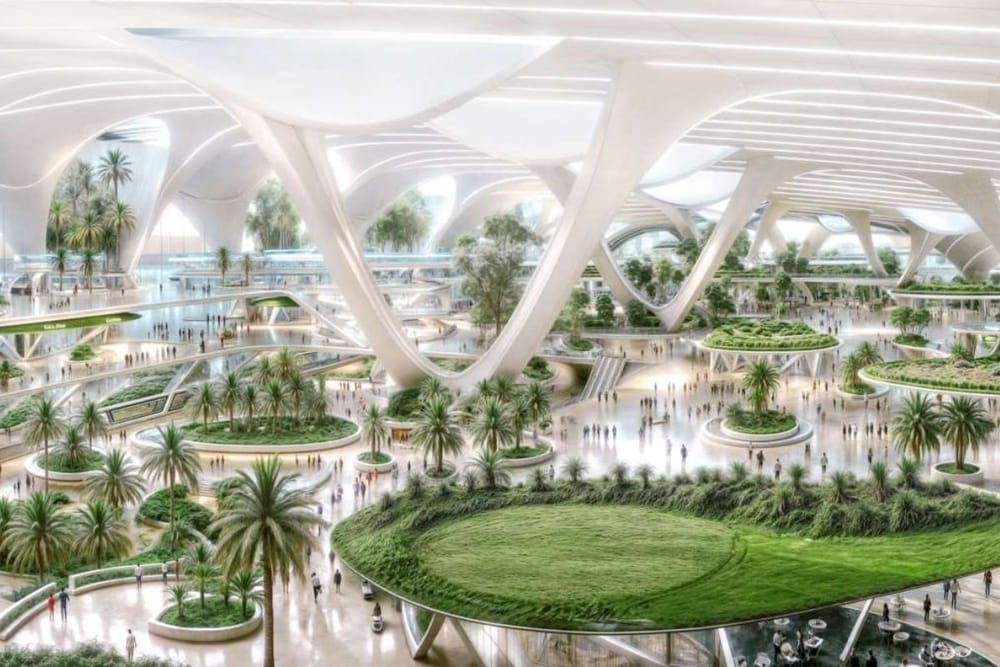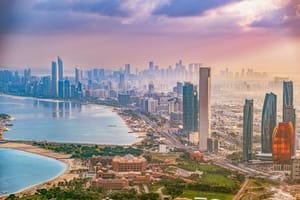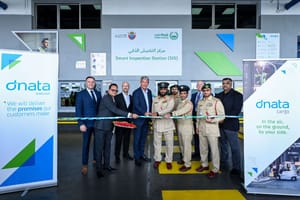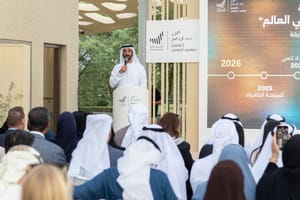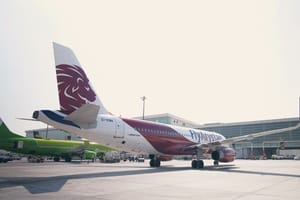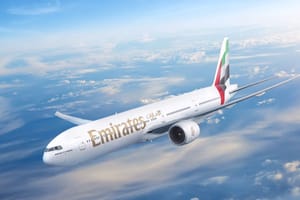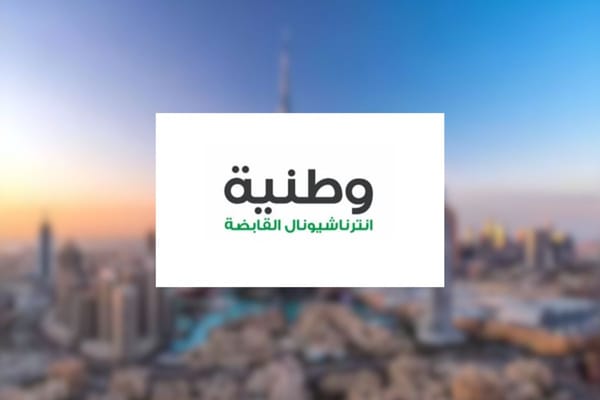A thorough overview of the design of the largest airport in the world is being shown to visitors of the 23rd Airport Show.
Dubai's Al Maktoum International Airport (DWC) is poised to become a city within itself, boasting its own transportation network, green spaces, entertainment zones, and retail outlets. Sheikh Mohammed bin Rashid Al Maktoum, Vice-President, Prime Minister of the UAE and Ruler of Dubai, unveiled initial images of the new passenger terminal in a recent tweet.
At the 23rd Airport Show, Dubai Aviation Engineering Projects (DAEP) provided a detailed glimpse into the airport's design, showcasing features like an elevated rail system traversing an indoor tropical forest and expansive LED screens depicting landscapes and marine environments.
According to DAEP, DWC aims to offer passengers unparalleled comfort, recreation, and mobility.
Well-connected

DAEP emphasizes that the design of DWC seamlessly blends tradition, culture, and innovation. The airport will boast excellent connectivity to Dubai and the UAE through various modes of transportation, including the high-speed rail (Etihad Rail), a new Metro line, air taxis, and autonomous vehicles.
Travelers can conveniently check-in their luggage from hotels, designated city desks, or even from their homes prior to arriving at the airport. Multi-level highways will lead passengers to the airport, where they will be welcomed by the world's largest sun canopy at the curbside drop-off zone.
World’s largest canopy

Inside the terminal, passengers will be greeted by a sprawling green zone, symbolizing Dubai's zero-carbon ambition. Giant LED screens will welcome them with various designs, including an impressive indoor aquarium projection.
The passenger terminals will be adorned with trees, creating a refreshing atmosphere, while vast green zones, including an indoor tropical garden, will provide relaxation opportunities. With a total area of 70 square kilometers, DWC will feature 400 aircraft gates and five parallel runways. Ample space will be allocated for shops, restaurants, entertainment, and relaxation areas.
First and business class lounges will be located on the upper level, with boarding gates conveniently lined along the piers for smooth aircraft access via multiple boarding bridges.
Automated face recognition
Once completed, DWC will surpass Dubai International Airport (DXB) in size by fivefold. The new airport will introduce cutting-edge technologies previously unseen in the aviation sector, including advanced face recognition systems to streamline entry into departure gates and minimize queues.
The west terminal building will cater to origin and destination passengers, featuring dedicated halls for first and business class, as well as economy class travelers.
At the gates, a 14-station automated people mover (APM) will efficiently transport passengers between terminals and concourses, simplifying transfers and ensuring a seamless journey for connecting flights.
Intuitive and personalized wayfinding systems will assist travelers throughout their transfers, with touchless security gates enhancing the overall passenger experience.
Underground baggage network
Baggage handling at DWC will be revolutionized through an underground network of galleries and batch centers capable of processing up to 30,000 bags per hour. This system will undergo a rigorous security and sorting process utilizing automated guided vehicles and advanced screening techniques. Subsequently, bags will be delivered directly to aircraft stands via pop-up hatches, minimizing disruption to ground handling activities on the airfield.
Additionally, automated bots will facilitate baggage drop-offs at the curb side, while trackable systems will ensure predictable baggage collection and seamless wayfinding for passengers.
Four simultaneous aircraft approaches
DWC will feature five parallel runways designed to accommodate code F aircraft, such as the B747-800 and A-380, known for their heavier weight and longer dimensions. Four of these runways will be spaced over 1,500 meters apart, enabling up to four simultaneous parallel aircraft approaches.
Each of the 4.5-kilometer runways will boast state-of-the-art aircraft guiding systems for enhanced safety and operational efficiency. Additionally, the airfield will incorporate rapid exits, double taxiways, and expansive ground service equipment roads. To further ensure safety and effective air traffic management, a second control tower will be positioned at the center of the airfield.
Environmental standards

DAEP has outlined plans for DWC operations to achieve complete sustainability. The airport's terminals and concourses will be powered entirely by clean energy sources, predominantly through the utilization of photovoltaic solar panels. The buildings will feature high-performance insulation and solar glazing to regulate energy consumption effectively.
In collaboration with the Dubai Municipality, a comprehensive recycling strategy will be implemented to achieve zero waste to landfill. Water conservation efforts will include the use of efficient appliances, greywater treatment plants, and the collection of condensation and rainwater, aiming to reduce water consumption by approximately 70 percent.
Estimated cost
Construction of the new passenger terminal at DWC will commence promptly, with an approximate budget of Dh128 billion allocated for the project. Upon completion, the airport is anticipated to handle nearly 260 million passengers and 12 million tonnes of cargo annually.
DAEP emphasized that the development aims to proactively address escalating passenger demands, surpassing projections, and ultimately positioning Dubai as the premier aviation hub globally.
Must Read: Things to Do - Thrilling Activities In Dubai
News Source: Khaleej Times
